2017 FORD F SERIES MOTORHOME AND COMMERCIAL CHASSIS trailer
[x] Cancel search: trailerPage 85 of 164
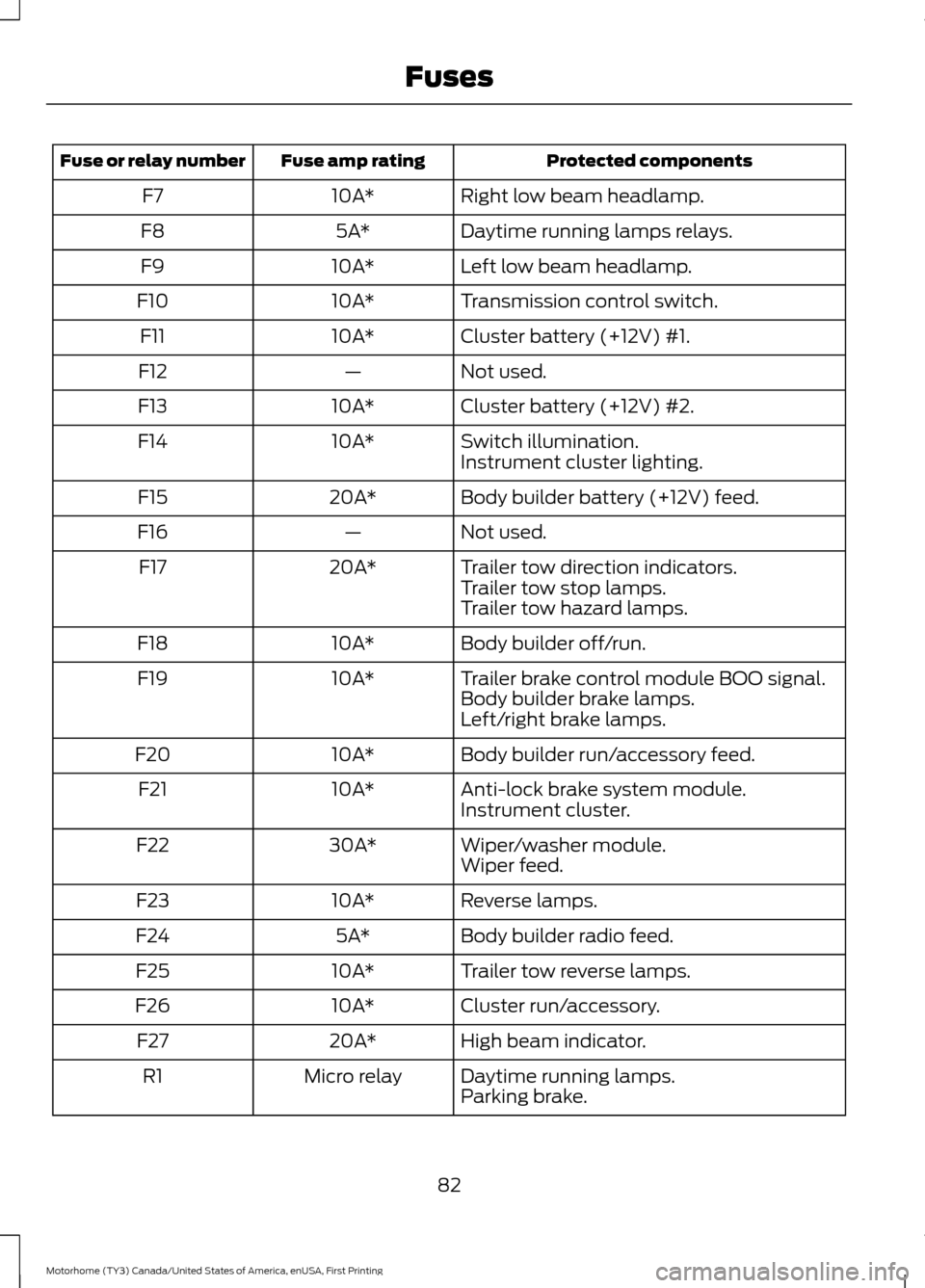
Protected components
Fuse amp rating
Fuse or relay number
Right low beam headlamp.
10A*
F7
Daytime running lamps relays.
5A*
F8
Left low beam headlamp.
10A*
F9
Transmission control switch.
10A*
F10
Cluster battery (+12V) #1.
10A*
F11
Not used.
—
F12
Cluster battery (+12V) #2.
10A*
F13
Switch illumination.
10A*
F14
Instrument cluster lighting.
Body builder battery (+12V) feed.
20A*
F15
Not used.
—
F16
Trailer tow direction indicators.
20A*
F17
Trailer tow stop lamps.
Trailer tow hazard lamps.
Body builder off/run.
10A*
F18
Trailer brake control module BOO signal.
10A*
F19
Body builder brake lamps.
Left/right brake lamps.
Body builder run/accessory feed.
10A*
F20
Anti-lock brake system module.
10A*
F21
Instrument cluster.
Wiper/washer module.
30A*
F22
Wiper feed.
Reverse lamps.
10A*
F23
Body builder radio feed.
5A*
F24
Trailer tow reverse lamps.
10A*
F25
Cluster run/accessory.
10A*
F26
High beam indicator.
20A*
F27
Daytime running lamps.
Micro relay
R1
Parking brake.
82
Motorhome (TY3) Canada/United States of America, enUSA, First Printing Fuses
Page 86 of 164
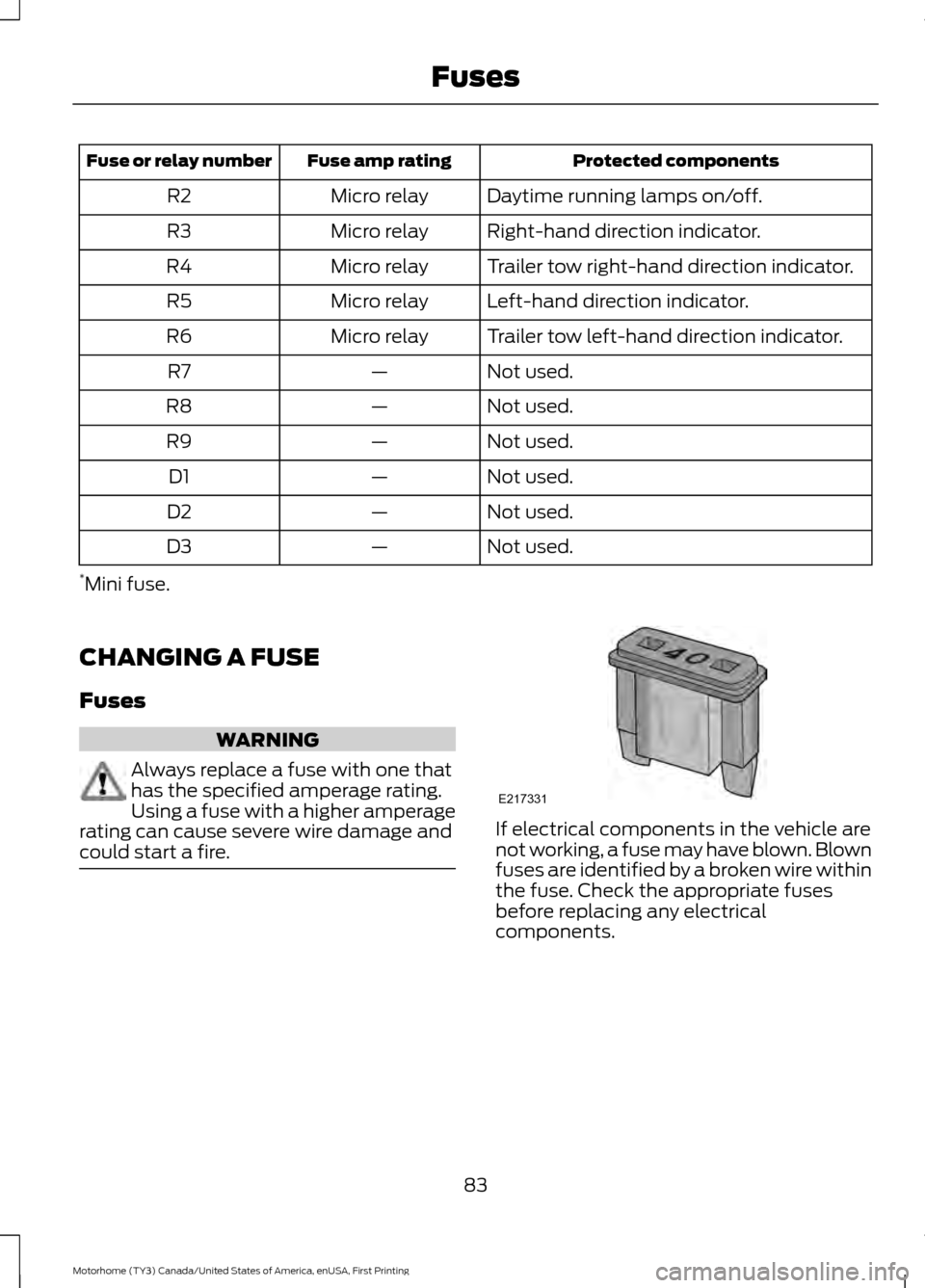
Protected components
Fuse amp rating
Fuse or relay number
Daytime running lamps on/off.
Micro relay
R2
Right-hand direction indicator.
Micro relay
R3
Trailer tow right-hand direction indicator.
Micro relay
R4
Left-hand direction indicator.
Micro relay
R5
Trailer tow left-hand direction indicator.
Micro relay
R6
Not used.
—
R7
Not used.
—
R8
Not used.
—
R9
Not used.
—
D1
Not used.
—
D2
Not used.
—
D3
* Mini fuse.
CHANGING A FUSE
Fuses WARNING
Always replace a fuse with one that
has the specified amperage rating.
Using a fuse with a higher amperage
rating can cause severe wire damage and
could start a fire. If electrical components in the vehicle are
not working, a fuse may have blown. Blown
fuses are identified by a broken wire within
the fuse. Check the appropriate fuses
before replacing any electrical
components.
83
Motorhome (TY3) Canada/United States of America, enUSA, First Printing FusesE217331
Page 96 of 164
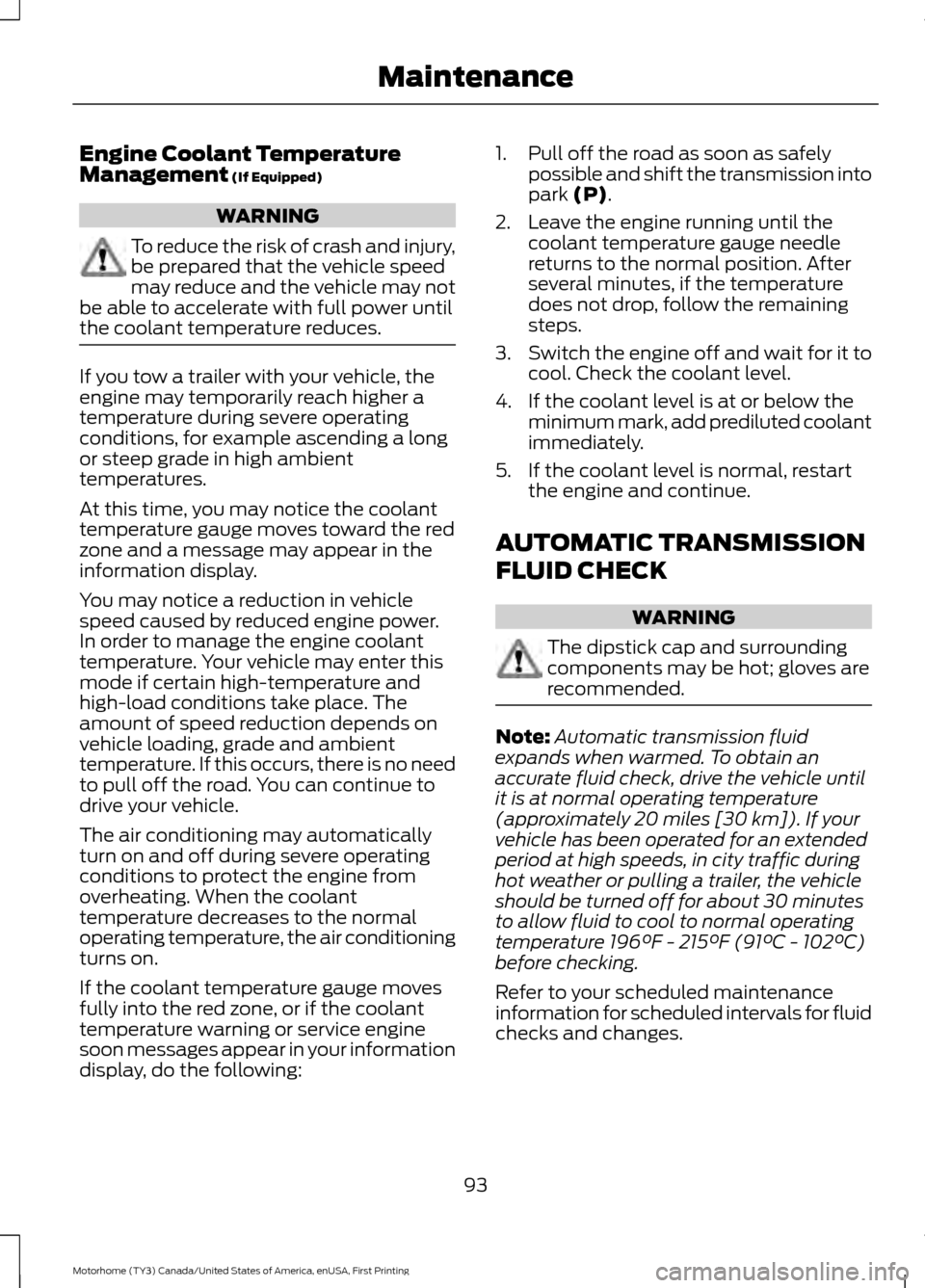
Engine Coolant Temperature
Management (If Equipped)
WARNING
To reduce the risk of crash and injury,
be prepared that the vehicle speed
may reduce and the vehicle may not
be able to accelerate with full power until
the coolant temperature reduces. If you tow a trailer with your vehicle, the
engine may temporarily reach higher a
temperature during severe operating
conditions, for example ascending a long
or steep grade in high ambient
temperatures.
At this time, you may notice the coolant
temperature gauge moves toward the red
zone and a message may appear in the
information display.
You may notice a reduction in vehicle
speed caused by reduced engine power.
In order to manage the engine coolant
temperature. Your vehicle may enter this
mode if certain high-temperature and
high-load conditions take place. The
amount of speed reduction depends on
vehicle loading, grade and ambient
temperature. If this occurs, there is no need
to pull off the road. You can continue to
drive your vehicle.
The air conditioning may automatically
turn on and off during severe operating
conditions to protect the engine from
overheating. When the coolant
temperature decreases to the normal
operating temperature, the air conditioning
turns on.
If the coolant temperature gauge moves
fully into the red zone, or if the coolant
temperature warning or service engine
soon messages appear in your information
display, do the following: 1. Pull off the road as soon as safely
possible and shift the transmission into
park (P).
2. Leave the engine running until the coolant temperature gauge needle
returns to the normal position. After
several minutes, if the temperature
does not drop, follow the remaining
steps.
3. Switch the engine off and wait for it to
cool. Check the coolant level.
4. If the coolant level is at or below the minimum mark, add prediluted coolant
immediately.
5. If the coolant level is normal, restart the engine and continue.
AUTOMATIC TRANSMISSION
FLUID CHECK WARNING
The dipstick cap and surrounding
components may be hot; gloves are
recommended.
Note:
Automatic transmission fluid
expands when warmed. To obtain an
accurate fluid check, drive the vehicle until
it is at normal operating temperature
(approximately 20 miles [30 km]). If your
vehicle has been operated for an extended
period at high speeds, in city traffic during
hot weather or pulling a trailer, the vehicle
should be turned off for about 30 minutes
to allow fluid to cool to normal operating
temperature 196°F - 215°F (91°C - 102°C)
before checking.
Refer to your scheduled maintenance
information for scheduled intervals for fluid
checks and changes.
93
Motorhome (TY3) Canada/United States of America, enUSA, First Printing Maintenance
Page 124 of 164
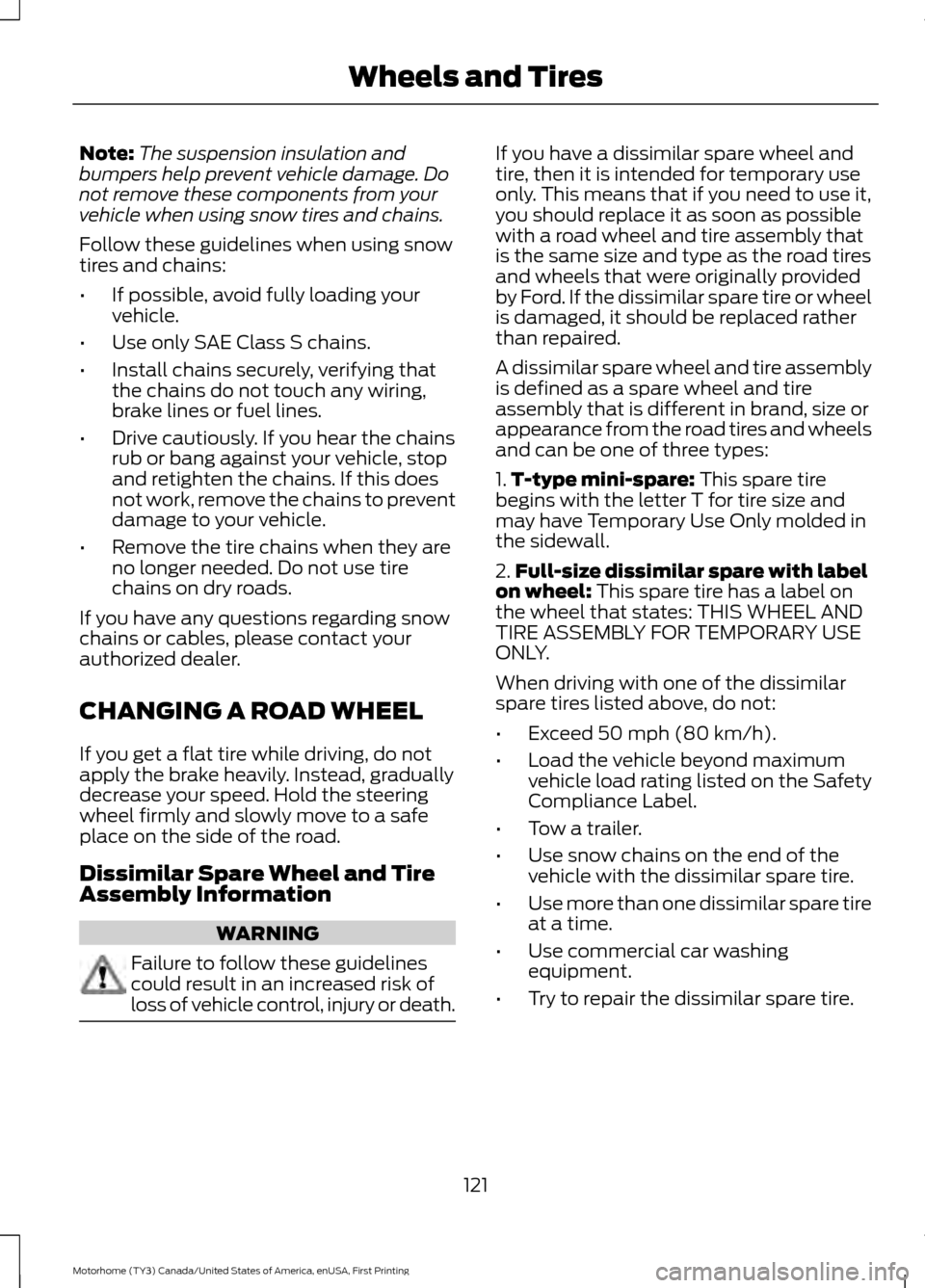
Note:
The suspension insulation and
bumpers help prevent vehicle damage. Do
not remove these components from your
vehicle when using snow tires and chains.
Follow these guidelines when using snow
tires and chains:
• If possible, avoid fully loading your
vehicle.
• Use only SAE Class S chains.
• Install chains securely, verifying that
the chains do not touch any wiring,
brake lines or fuel lines.
• Drive cautiously. If you hear the chains
rub or bang against your vehicle, stop
and retighten the chains. If this does
not work, remove the chains to prevent
damage to your vehicle.
• Remove the tire chains when they are
no longer needed. Do not use tire
chains on dry roads.
If you have any questions regarding snow
chains or cables, please contact your
authorized dealer.
CHANGING A ROAD WHEEL
If you get a flat tire while driving, do not
apply the brake heavily. Instead, gradually
decrease your speed. Hold the steering
wheel firmly and slowly move to a safe
place on the side of the road.
Dissimilar Spare Wheel and Tire
Assembly Information WARNING
Failure to follow these guidelines
could result in an increased risk of
loss of vehicle control, injury or death. If you have a dissimilar spare wheel and
tire, then it is intended for temporary use
only. This means that if you need to use it,
you should replace it as soon as possible
with a road wheel and tire assembly that
is the same size and type as the road tires
and wheels that were originally provided
by Ford. If the dissimilar spare tire or wheel
is damaged, it should be replaced rather
than repaired.
A dissimilar spare wheel and tire assembly
is defined as a spare wheel and tire
assembly that is different in brand, size or
appearance from the road tires and wheels
and can be one of three types:
1.
T-type mini-spare: This spare tire
begins with the letter T for tire size and
may have Temporary Use Only molded in
the sidewall.
2. Full-size dissimilar spare with label
on wheel:
This spare tire has a label on
the wheel that states: THIS WHEEL AND
TIRE ASSEMBLY FOR TEMPORARY USE
ONLY.
When driving with one of the dissimilar
spare tires listed above, do not:
• Exceed
50 mph (80 km/h).
• Load the vehicle beyond maximum
vehicle load rating listed on the Safety
Compliance Label.
• Tow a trailer.
• Use snow chains on the end of the
vehicle with the dissimilar spare tire.
• Use more than one dissimilar spare tire
at a time.
• Use commercial car washing
equipment.
• Try to repair the dissimilar spare tire.
121
Motorhome (TY3) Canada/United States of America, enUSA, First Printing Wheels and Tires
Page 125 of 164
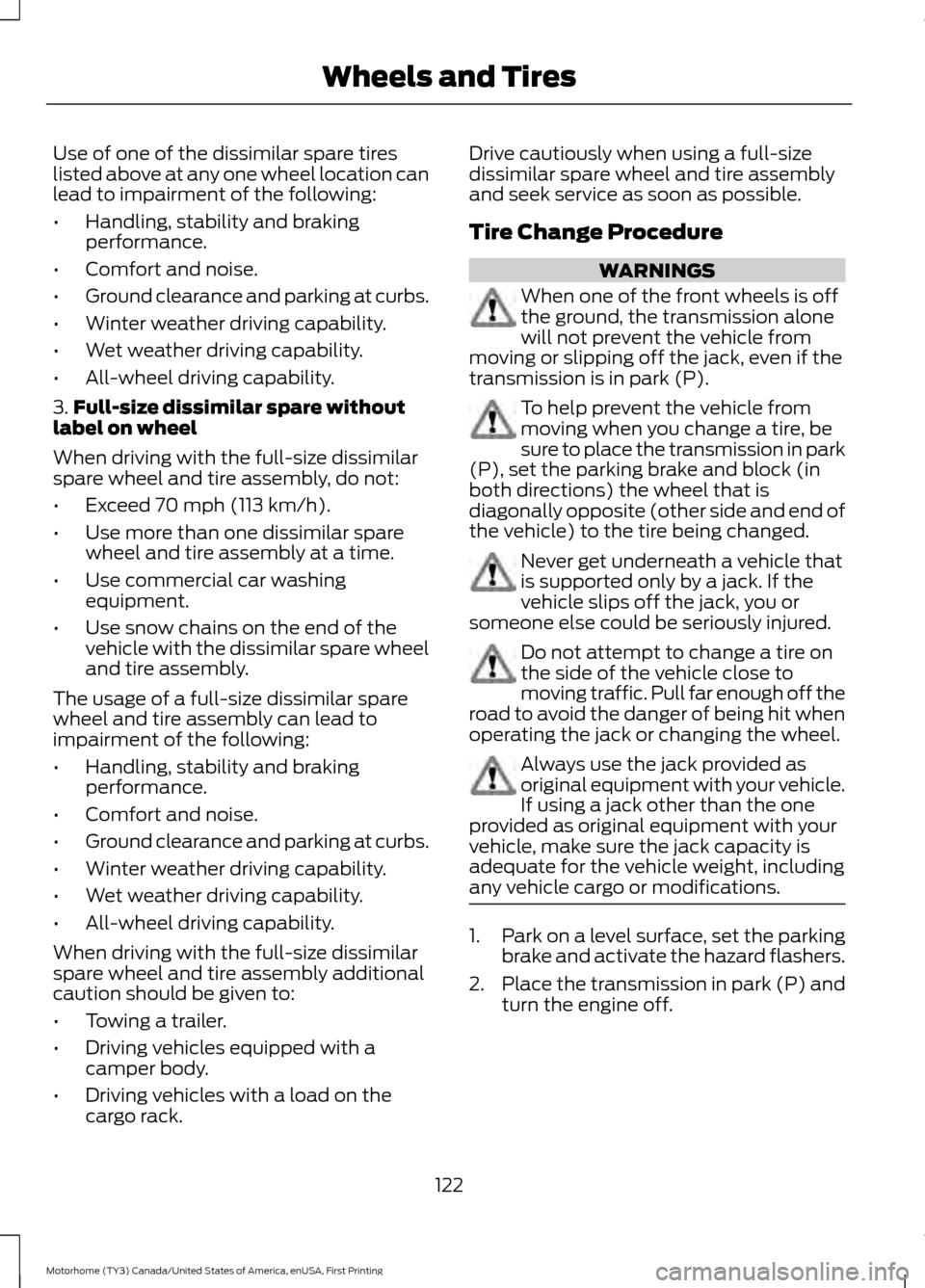
Use of one of the dissimilar spare tires
listed above at any one wheel location can
lead to impairment of the following:
•
Handling, stability and braking
performance.
• Comfort and noise.
• Ground clearance and parking at curbs.
• Winter weather driving capability.
• Wet weather driving capability.
• All-wheel driving capability.
3. Full-size dissimilar spare without
label on wheel
When driving with the full-size dissimilar
spare wheel and tire assembly, do not:
• Exceed 70 mph (113 km/h).
• Use more than one dissimilar spare
wheel and tire assembly at a time.
• Use commercial car washing
equipment.
• Use snow chains on the end of the
vehicle with the dissimilar spare wheel
and tire assembly.
The usage of a full-size dissimilar spare
wheel and tire assembly can lead to
impairment of the following:
• Handling, stability and braking
performance.
• Comfort and noise.
• Ground clearance and parking at curbs.
• Winter weather driving capability.
• Wet weather driving capability.
• All-wheel driving capability.
When driving with the full-size dissimilar
spare wheel and tire assembly additional
caution should be given to:
• Towing a trailer.
• Driving vehicles equipped with a
camper body.
• Driving vehicles with a load on the
cargo rack. Drive cautiously when using a full-size
dissimilar spare wheel and tire assembly
and seek service as soon as possible.
Tire Change Procedure
WARNINGS
When one of the front wheels is off
the ground, the transmission alone
will not prevent the vehicle from
moving or slipping off the jack, even if the
transmission is in park (P). To help prevent the vehicle from
moving when you change a tire, be
sure to place the transmission in park
(P), set the parking brake and block (in
both directions) the wheel that is
diagonally opposite (other side and end of
the vehicle) to the tire being changed. Never get underneath a vehicle that
is supported only by a jack. If the
vehicle slips off the jack, you or
someone else could be seriously injured. Do not attempt to change a tire on
the side of the vehicle close to
moving traffic. Pull far enough off the
road to avoid the danger of being hit when
operating the jack or changing the wheel. Always use the jack provided as
original equipment with your vehicle.
If using a jack other than the one
provided as original equipment with your
vehicle, make sure the jack capacity is
adequate for the vehicle weight, including
any vehicle cargo or modifications. 1.
Park on a level surface, set the parking
brake and activate the hazard flashers.
2. Place the transmission in park (P) and
turn the engine off.
122
Motorhome (TY3) Canada/United States of America, enUSA, First Printing Wheels and Tires
Page 144 of 164
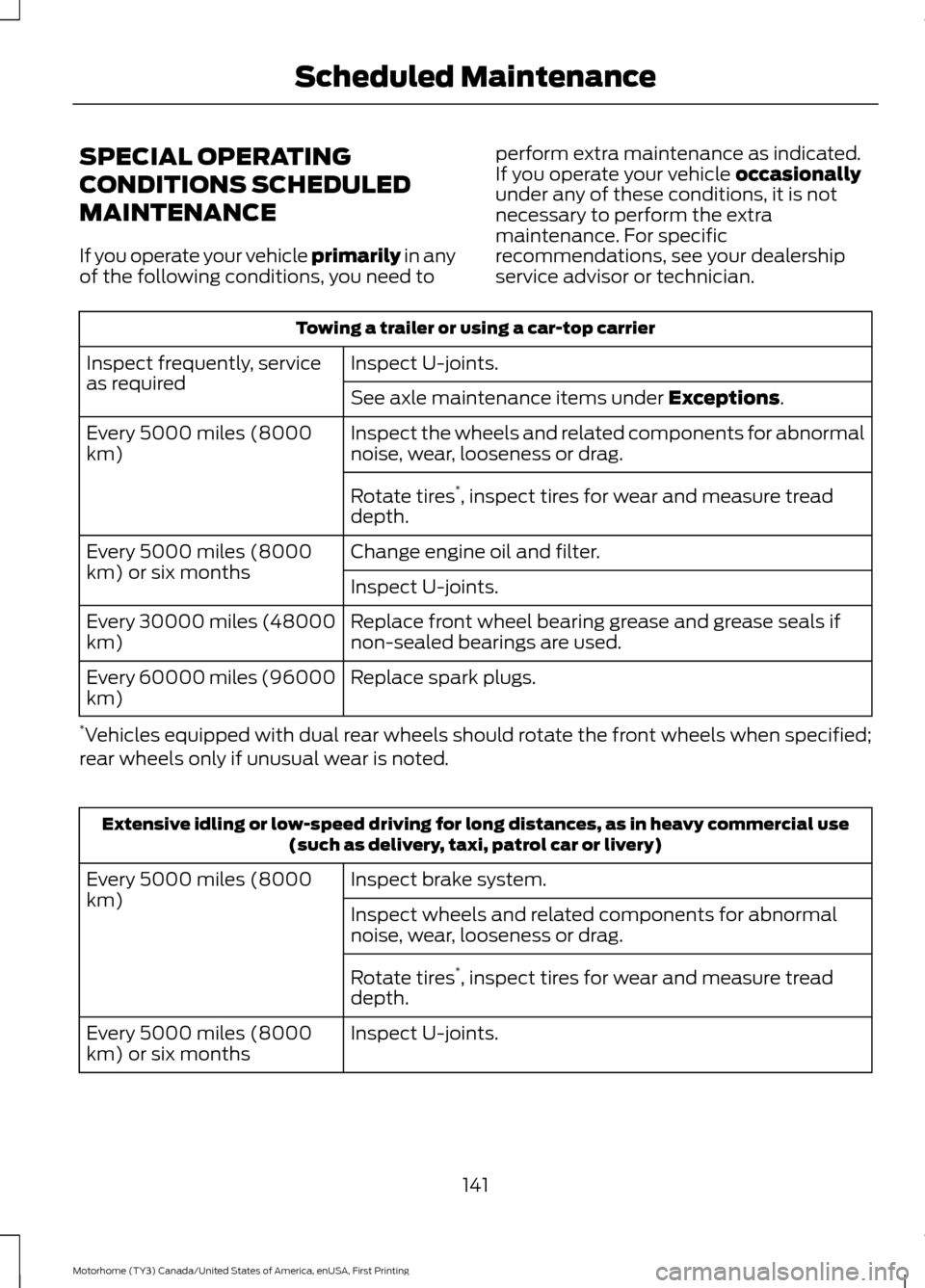
SPECIAL OPERATING
CONDITIONS SCHEDULED
MAINTENANCE
If you operate your vehicle primarily in any
of the following conditions, you need to perform extra maintenance as indicated.
If you operate your vehicle
occasionally
under any of these conditions, it is not
necessary to perform the extra
maintenance. For specific
recommendations, see your dealership
service advisor or technician. Towing a trailer or using a car-top carrier
Inspect U-joints.
Inspect frequently, service
as required
See axle maintenance items under
Exceptions.
Inspect the wheels and related components for abnormal
noise, wear, looseness or drag.
Every 5000 miles (8000
km)
Rotate tires*
, inspect tires for wear and measure tread
depth.
Change engine oil and filter.
Every 5000 miles (8000
km) or six months
Inspect U-joints.
Replace front wheel bearing grease and grease seals if
non-sealed bearings are used.
Every 30000 miles (48000
km)
Replace spark plugs.
Every 60000 miles (96000
km)
* Vehicles equipped with dual rear wheels should rotate the front wheels when specified;
rear wheels only if unusual wear is noted. Extensive idling or low-speed driving for long distances, as in heavy commercial use
(such as delivery, taxi, patrol car or livery)
Inspect brake system.
Every 5000 miles (8000
km)
Inspect wheels and related components for abnormal
noise, wear, looseness or drag.
Rotate tires*
, inspect tires for wear and measure tread
depth.
Inspect U-joints.
Every 5000 miles (8000
km) or six months
141
Motorhome (TY3) Canada/United States of America, enUSA, First Printing Scheduled Maintenance
Page 146 of 164
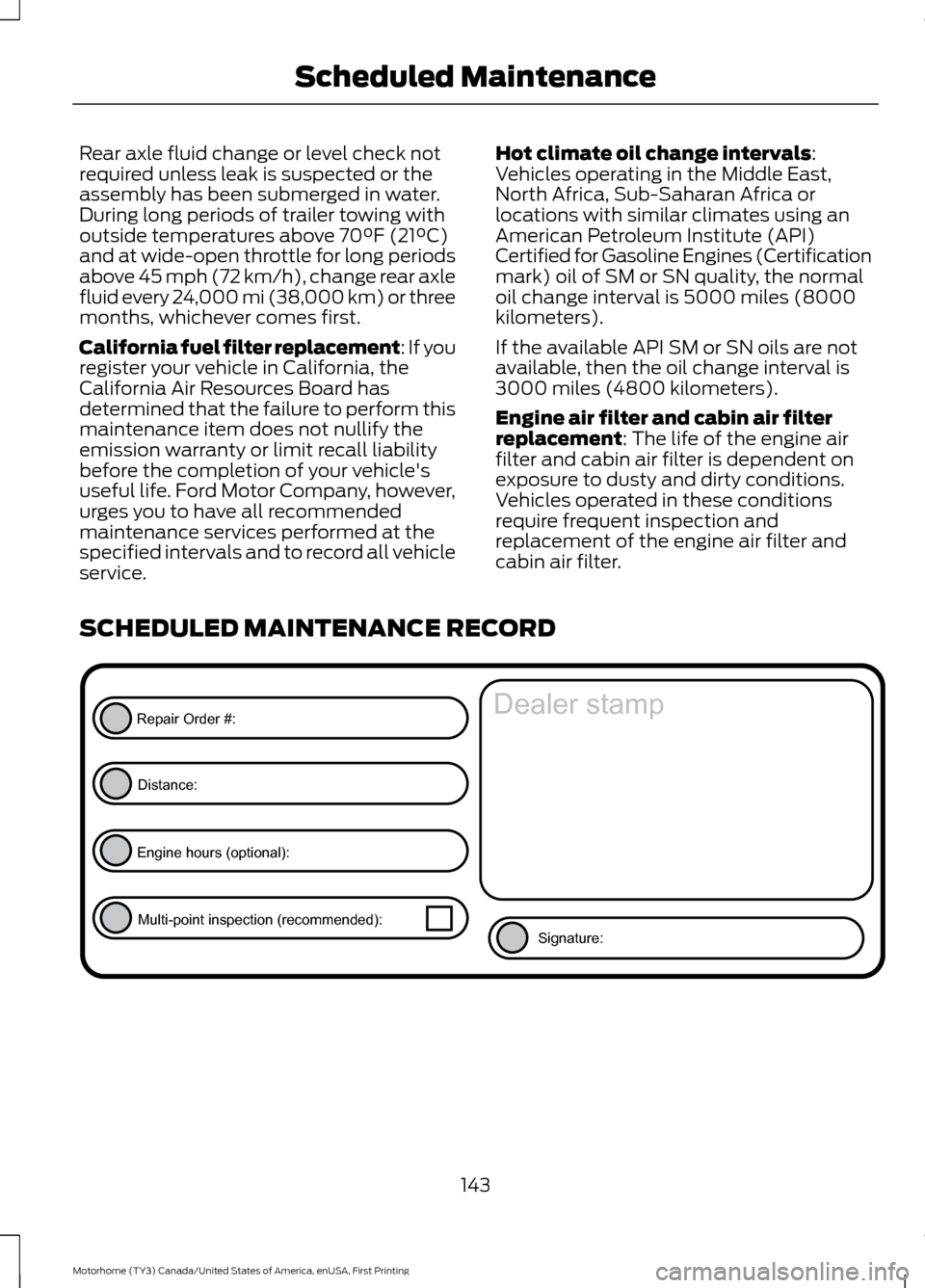
Rear axle fluid change or level check not
required unless leak is suspected or the
assembly has been submerged in water.
During long periods of trailer towing with
outside temperatures above 70°F (21°C)
and at wide-open throttle for long periods
above 45 mph (72 km/h), change rear axle
fluid every 24,000 mi (38,000 km) or three
months, whichever comes first.
California fuel filter replacement: If you
register your vehicle in California, the
California Air Resources Board has
determined that the failure to perform this
maintenance item does not nullify the
emission warranty or limit recall liability
before the completion of your vehicle's
useful life. Ford Motor Company, however,
urges you to have all recommended
maintenance services performed at the
specified intervals and to record all vehicle
service.
Hot climate oil change intervals:
Vehicles operating in the Middle East,
North Africa, Sub-Saharan Africa or
locations with similar climates using an
American Petroleum Institute (API)
Certified for Gasoline Engines (Certification
mark) oil of SM or SN quality, the normal
oil change interval is 5000 miles (8000
kilometers).
If the available API SM or SN oils are not
available, then the oil change interval is
3000 miles (4800 kilometers).
Engine air filter and cabin air filter
replacement
: The life of the engine air
filter and cabin air filter is dependent on
exposure to dusty and dirty conditions.
Vehicles operated in these conditions
require frequent inspection and
replacement of the engine air filter and
cabin air filter.
SCHEDULED MAINTENANCE RECORD 143
Motorhome (TY3) Canada/United States of America, enUSA, First Printing Scheduled MaintenanceE146852
Repair Order #:Distance:
Engine hours (optional): Multi-point inspection (recommended): Signature:
Dealer stamp
Page 161 of 164
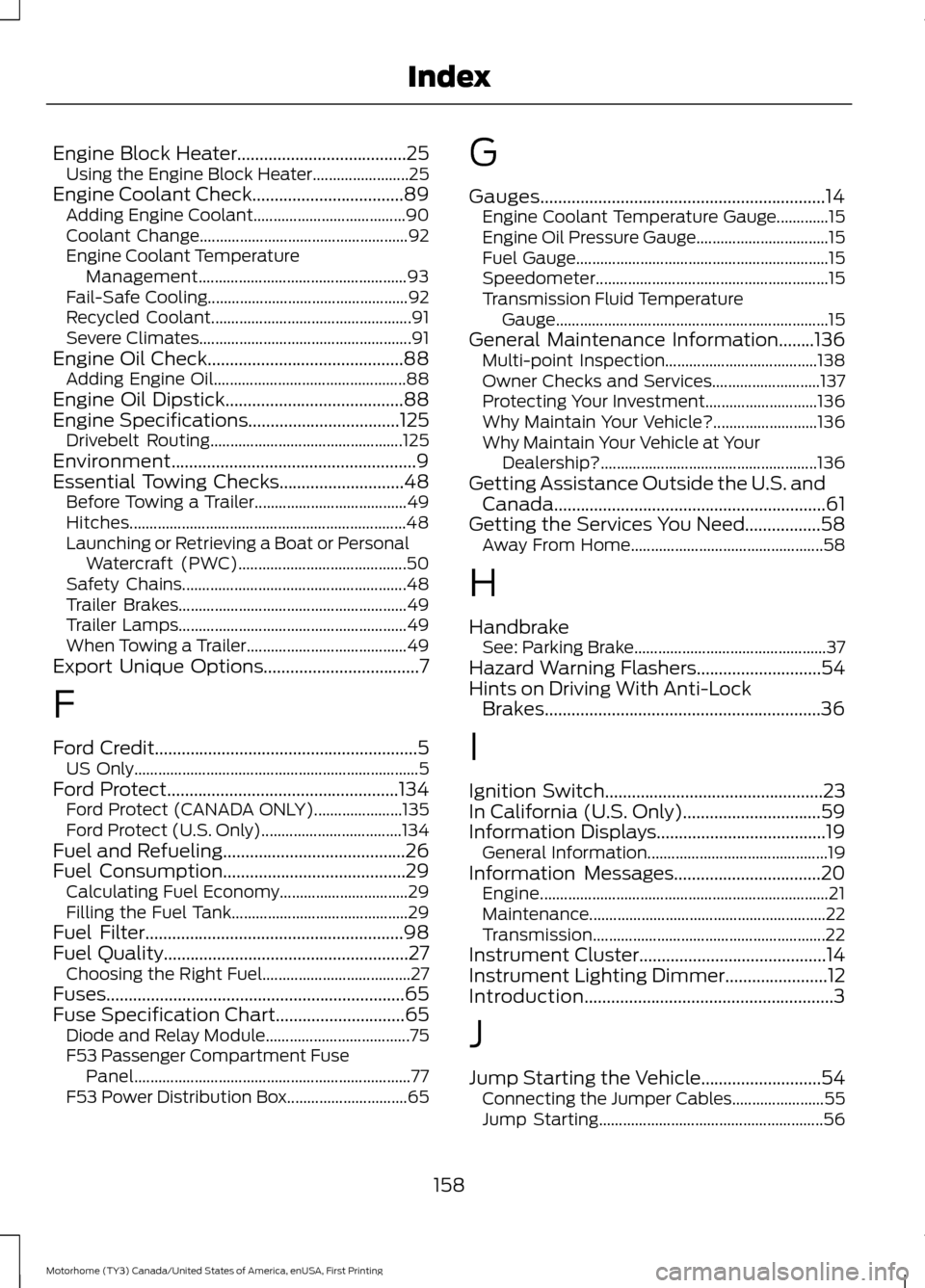
Engine Block Heater......................................25
Using the Engine Block Heater........................ 25
Engine Coolant Check..................................89
Adding Engine Coolant...................................... 90
Coolant Change.................................................... 92
Engine Coolant Temperature Management.................................................... 93
Fail-Safe Cooling.................................................. 92
Recycled Coolant.................................................. 91
Severe Climates..................................................... 91
Engine Oil Check............................................88 Adding Engine Oil................................................ 88
Engine Oil Dipstick
........................................88
Engine Specifications..................................125
Drivebelt Routing................................................ 125
Environment.......................................................9
Essential Towing Checks............................48 Before Towing a Trailer...................................... 49
Hitches..................................................................... 48
Launching or Retrieving a Boat or Personal Watercraft (PWC).......................................... 50
Safety Chains........................................................ 48
Trailer Brakes......................................................... 49
Trailer Lamps......................................................... 49
When Towing a Trailer........................................ 49
Export Unique Options
...................................7
F
Ford Credit...........................................................5 US Only....................................................................... 5
Ford Protect....................................................134 Ford Protect (CANADA ONLY)...................... 135
Ford Protect (U.S. Only)................................... 134
Fuel and Refueling.........................................26
Fuel Consumption
.........................................29
Calculating Fuel Economy................................ 29
Filling the Fuel Tank............................................ 29
Fuel Filter
..........................................................98
Fuel Quality.......................................................27
Choosing the Right Fuel..................................... 27
Fuses...................................................................65
Fuse Specification Chart
.............................65
Diode and Relay Module.................................... 75
F53 Passenger Compartment Fuse Panel..................................................................... 77
F53 Power Distribution Box.............................. 65G
Gauges
................................................................14
Engine Coolant Temperature Gauge.............15
Engine Oil Pressure Gauge................................. 15
Fuel Gauge............................................................... 15
Speedometer.......................................................... 15
Transmission Fluid Temperature Gauge.................................................................... 15
General Maintenance Information
........136
Multi-point Inspection...................................... 138
Owner Checks and Services........................... 137
Protecting Your Investment............................ 136
Why Maintain Your Vehicle?.......................... 136
Why Maintain Your Vehicle at Your Dealership?...................................................... 136
Getting Assistance Outside the U.S. and Canada.............................................................61
Getting the Services You Need
.................58
Away From Home................................................ 58
H
Handbrake See: Parking Brake................................................ 37
Hazard Warning Flashers............................54
Hints on Driving With Anti-Lock Brakes..............................................................36
I
Ignition Switch
.................................................23
In California (U.S. Only)...............................59
Information Displays
......................................19
General Information............................................. 19
Information Messages
.................................20
Engine........................................................................\
21
Maintenance........................................................... 22
Transmission.......................................................... 22
Instrument Cluster
..........................................14
Instrument Lighting Dimmer.......................12
Introduction........................................................3
J
Jump Starting the Vehicle...........................54 Connecting the Jumper Cables....................... 55
Jump Starting........................................................ 56
158
Motorhome (TY3) Canada/United States of America, enUSA, First Printing Index